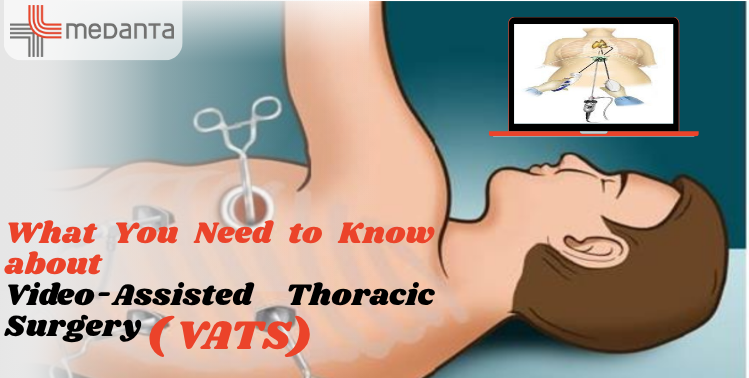CH Baktawar Singh Rd, Medicity, Islampur Colony, Sector 38, Gurugram, Haryana 122001

30 September, 2025
adminVideo-Assisted Thoracic Surgery (often referred to as VATS, which stands for video-assisted thoracic surgery) refers to a form of minimally invasive surgery, by which physicians examine or treat (myopathology) of the chest (thorax), as well as the lungs, pleura, mediastinum, and occasionally the esophagus. Opened instead of excavating the ribs through large cuts and disseminating or cutting through them (as in conventional thoracotomy), VATS advises small incisions through which a small camera (thoracoscope) and other special tools are introduced. This enables the surgeon to make precision surgical operations that are less traumatic by enabling him, or her, to visualize the inside of the chest using a video monitor.
Video-Assisted Thoracic Surgery (VATS) has quickly grown to be a popular choice of treatment wherever caring patients across the globe go in search of high-quality treatment at low prices. The nation introduces the latest technology with well trained thoracic surgeons hence obtaining one of the most dependable locations in regard to the advanced chest and lung surgeries.
As far as VATS surgery in India is concerned, Dr. Harsh Vardhan Puri is a reliable person. Having the experience and expertise in thoracic surgery, lung transplantation and modern minimally invasive surgery, Dr. Puri is offering a holistic treatment method; through proper diagnosis, intensive surgery as well as recovery. Excellence has seen him become a choice to domestic and international patients.
Among the conditions that VATS can be applied to are:
When compared with conventional open surgeries (thoracotomy), using VATS has a number of benefits, they are:
No surgery is without risk. The potential risks/limitations of VATS are:
1.Leaks of the tissues causing lung damage can be depressing and thus makes it take long before the patient is discharged.
2.Bleeding risk, risk of infection or anesthesia adverse reactions.
3.The requirement to change to open thoracotomy in case the sight or access is insufficient.
4.VATS is not available in every patient (e.g. very large tumours, cancer in a very late stage with complicated involvement) or situation (e.g., cortical tumours). Selecting the patient is also significant.
( A) Before Surgery
Radiological examination CT scan, PET in case of necessity, pulmonary tests, and so forth.
Pre-operative testing: history, physical, had any co-morbidities (e.g., heart disease, lung disease).
Education on fasting, drugs, and potential smoking treatment.
( B) During Surgery
The patient is generally anesthetized.
The thoracoscope and instruments use small, rib separating incisions.
The target tissue is devitalized (e.g. part of lung, of lymph nodes, of mediastinal tumour etc.).
One is inserted with a chest tube to clear the air /fluid and allow the lung to re-expand.
( C) Recovery After Surgery
Brief hospitalization-most patients spend 1-3 days depending on a procedure and recovery.
Pain management: normally, not as heavy as during open surgery, but this matter is still important. Use of multimodal analgesia.
Early mobilization: ambulation, chest breathing to stop pneumonia.
Chest tube is taken out when the drainage is low and also when the expansion of lungs is satisfactory.
McGovern Medical School
Thoracic surgeon having over 15 years experience in lung transplantation and chest operations.
State of the art facility with an advanced centre based in minimally invasive thoracic surgery.
Personalised attention to the patient to guarantee safe selection of a patient, effective surgical practice, and follow up services.
Devotion to improved patient outcomes: reduce pain, speedy recovery, mild scarring.
Is VATS painful?
Wilms tumor-less invasive compared to the standard open chest operated process. A little bit of trouble in the beginning which it will counter with pain medication. Smaller incisions and minimal rib expansion mean that the pain enabler will recover earlier.
No. Scars lesser (many small ones frequently as opposed to a big incision). Cosmetically much better.
Depending on healing and procedure.Returning 2-4 weeks back is possible for many patients who work in offices, but more time can be expected in case of heavier work.
Not always. The dimensions, localization of disease (tumour etc.), the health of the patient, the capacity of the lungs with inhalation, and previous surgeries or adhesions may have an impact on the possibility of the use of VATS or if it is more safe to use an open procedure.
Video assisted thoracic surgery (VATS) is one of the most important innovations in thoracic surgeries. In conditions that require patients to undergo processes such as lung resections, biopsies, mediastinal mass removal, or treatment against pleural diseases; VATS has less pain, quicker recovery, reduced blood loss, smaller scars and better quality of life after the surgery. You should have all modern techniques, gentle treatment and good surgical results under the hands of an experience like Dr. Harsh Vardhan Puri.
Category : VATS Treatment
Tags: VATS